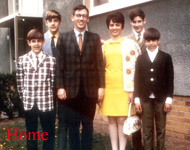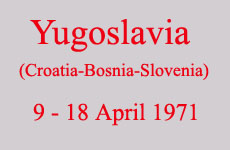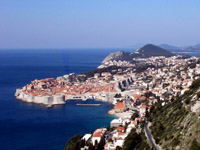Saturday, 17 April.
We had breakfast at the hotel and left Jajce, driving north along the Vrbas
River. We were gradually coming out of the mountains, but there were still many
people in Bosnian dress along the road. In about an hour we came to Banja Luka,
capital of Bosnia under the Ottomans. I had a minor dispute (communicating
entirely through gestures) at the Esso station there when the attendant insisted
that the official gas coupons we'd purchased at the border were only good for
regular gas. (Our Mercedes used premium.) The attendant finally made a phone
call and the matter was resolved. We asked the attendant for directions to the Fehrad Pasha
Mosque (Fehradija), just a couple of blocks away. The building we found on the site had no
minaret and didn't match the picture in our guidebook, so we didn't stop. We
finally located the tourist office with an English-speaking clerk. There we
learned that the city had been badly damaged by an earthquake just 18 months
earlier (October 1969). The
mosque had lost the upper part of its minaret and suffered other damage. All but
one of the city's hotels were still closed. We also learned that the bazaar
mentioned in our guidebook had closed. There was a bank on the corner with a pair of massive
revolutionary statues flanking the door. A friendly German-speaking guard took
us inside, even though the bank was closed. The employees also were very
friendly, selling us some hard to find five dinar coins, including one limited
edition "FAO" type. (Our boys collected complete sets of coins from each country
we visited.) We drove back to the Ferhad Pasha Mosque (1587) and looked around the outside, but it wasn't open to the public. We bought food for lunch at a little store and again the people were very friendly. Then we examined the large Kastel Fortress along the Vrbas River in the center of town. Although successive occupiers since the Romans have built and rebuilt fortifications there, the Ottoman turned it into the present large fortress. The Kastel houses the communist Museum of the Revolution with busts of heros who died fighting the Nazis. There were several old guns, a tank, airframe, and even a locomotive on the grounds. We continued north from Banja Luka and reached the autoput
(expressway) around noon. We were now in the broad, flat Sava River valley. For
the first time since we entered Yugoslavia we started seeing some regular farm
tractors. There were still horse-drawn plows and wagons, too. We ate our lunch
along the autoput, then headed for Zagreb. The autoput was a big disappointment. It was only two lanes, not
limited-access, and had a 50 kph (30 mph) speed limit. There was no restriction
on bicycles, tractors, or pedestrians, either. The road was also very rough. It
had been built largely by university students over a single summer as one of
Tito's modernization projects. Concrete was just poured on the ground with no
foundation beneath it. Naturally, the pavement settled or rose from frost,
causing an undulating ride. Fortunately, there was almost no other traffic on
the road and, with our air-suspension Mercedes, we were often able to drive about 50
mph without floating away. When we finally got to Zagreb (capital of Croatia), the autoput became just another city street. We found our way to the old part of the city, passing by Tomislavov Square and the railroad station. We went through the old Gothic Cathedral (13th century) and the old marketplace (Dolac) nearby. We also visited St. Mark's Church, which has the coats of arms of Zagreb and of Croatia in colored tiles on the roof. After less than two hours in Zagreb, though, we decided to push on to Ljubljiana (capital of Slovenia). The autoput to Ljubljana was much better than that east
of Zagreb. At least it wasn't as rough. By the time we reached Ljubljana, we were all getting pretty tired. The traffic was now
very heavy, and we also were suffering from "tourist overload†from seeing so
much in such a short time. The road to Postojna, our next destination, exited on
the south end of Ljubljana close to where we entered the city. After a brief
consultation, we decided not to drive into the historic center of Ljubljana, but
to go directly to Postojna. We got there just in time to check into the Kras Hotel ($5.00
per room with breakfast) and rush to the famous caves for the 18:00 tour, last
of the day. We were all provided with capes and hoods for the 90 minute tour. It
started with a two kilometer ride in an electric train. Then we walked about
another two kilometers. It was a beautiful, high and fascinating limestone cave. The feature attraction was the little proteus anguineus or "human fish" found only in that cave. They are amphibians, distantly related to newts, but much longer. They are a several inches long, the pink color of flesh, with four tiny limbs and, after countless millennia living in total darkness, have evolved without eyes. According to our guide, they live on algae and can go three months without eating. Several of them were kept in an open pool for tourists to see. They are kept there for a month, then they're returned to their home in the underground river and replaced by others. They are said to live up to 100 years. The boys really liked them. The last leg of the tour was back in the train which took us along a bank high above the Pivka River just before the cave opened to the outside. After dinner at the hotel, the boys went to their rooms. A very nice band had started playing in the dining room, and Jane and I stayed to dance.
[public_html/Travels/borderbottom.htm] |










